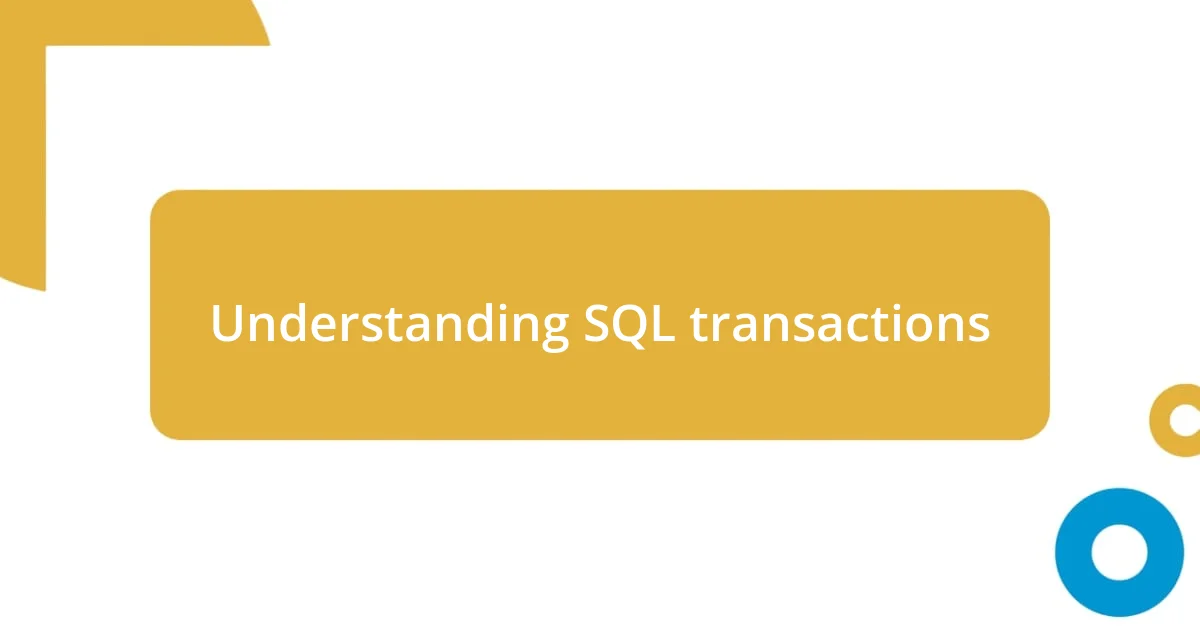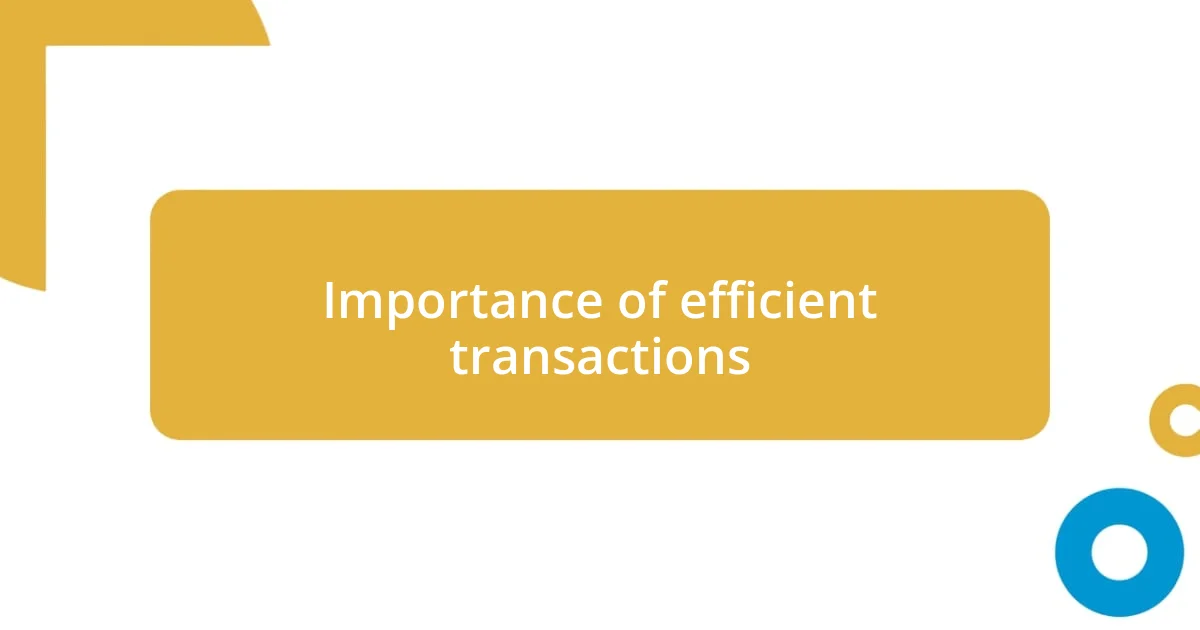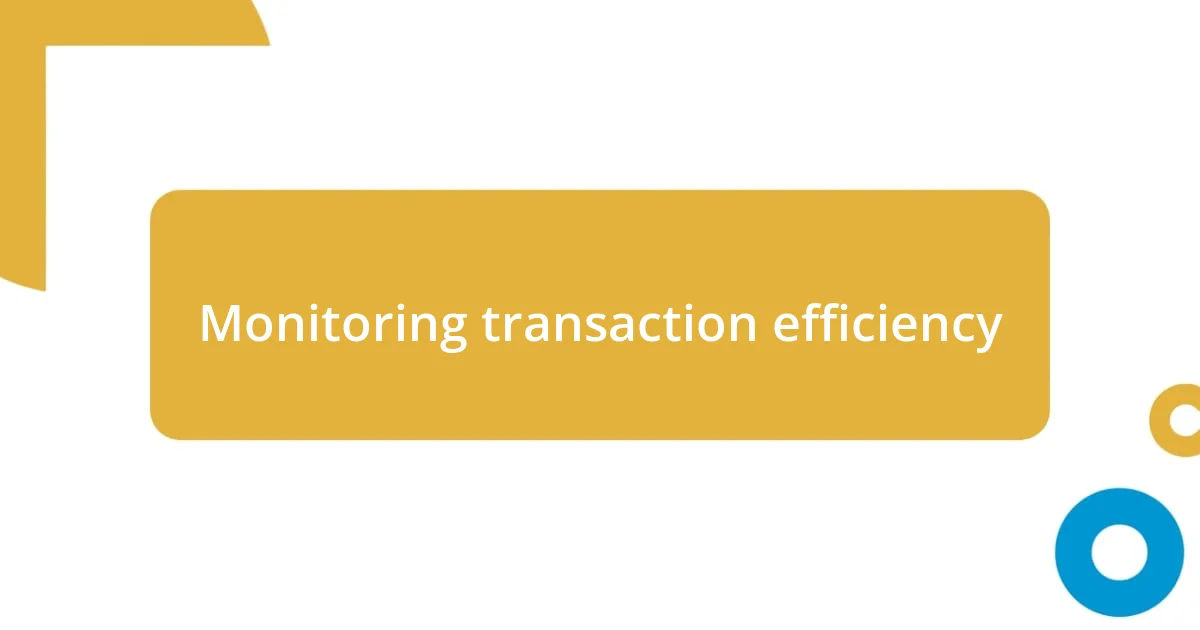Key takeaways:
- SQL transactions ensure data integrity through ACID properties (Atomicity, Consistency, Isolation, Durability), allowing for reliable operations across databases.
- Efficient transactions enhance data integrity, user experience, and scalability, which is vital for maintaining performance in high-load applications.
- Implementing best practices like minimizing lock duration, using savepoints, and monitoring transaction performance can significantly improve SQL transaction efficiency and error handling.

Understanding SQL transactions
When I first encountered SQL transactions, it felt a bit like navigating a labyrinth. Just as you wouldn’t want to leave parts of a puzzle unsolved, transactions ensure that a series of operations either completely succeed or fail together. Have you ever had that moment where everything seems to be working perfectly, only to realize a small error threw off the entire result? That’s where the strength of transactions lies—they ensure integrity.
At its core, an SQL transaction is a sequence of operations that are treated as a single logical unit. It’s fascinating to see how this functionality allows developers like me to maintain consistency and reliability in database systems. For example, when managing bank transfers, if one part of the transaction fails—say, debiting an account without crediting another—the whole operation can roll back, preventing potential chaos. Isn’t it reassuring to know that SQL can help safeguard your data in such a structured way?
Often, I find myself reflecting on the four critical properties of transactions, known as ACID: Atomicity, Consistency, Isolation, and Durability. Each plays a pivotal role in ensuring that data remains accurate and consistent. Think about how stressful it would be to think a transaction partially went through while another one executed next; it could lead to real headaches. Understanding these principles has not only elevated my technical skills but also deepened my appreciation for careful data management in everyday tasks.

Importance of efficient transactions
Efficient transactions are the backbone of any solid database management system. They not only enhance the database’s performance but also support consistent and reliable application behavior. I remember a time when a project I was working on experienced delays due to slow transactions. It was frustrating for both the team and the users who were eagerly waiting for updates. That experience reminded me just how pivotal transaction efficiency is in maintaining user satisfaction and system reliability.
The importance of efficient transactions goes beyond just speed; it directly impacts data integrity and security. When transactions are executed efficiently, the risk of data anomalies diminishes significantly. Speaking from my experience, I once handled a case where delays in transaction processing led to incorrect financial reports. The pressure was immense as we scrambled to rectify the discrepancies, learning firsthand how critical it is to ensure that every transaction runs smoothly and correctly.
Moreover, as applications scale, the need for efficient transactions becomes even more crucial. A well-optimized transaction can handle higher loads without compromising performance. I was involved in a project that experienced tremendous growth in user activity. We had worked hard to streamline our transactions beforehand, and that planning really paid off. It reinforced my belief that investing time in optimizing transactions is essential for scaling applications successfully.
| Aspect | Importance of Efficient Transactions |
|---|---|
| Data Integrity | Ensures all operations complete or fail together, preventing data corruption. |
| User Experience | Fast transactions lead to higher satisfaction and better engagement. |
| Scalability | Optimized transactions handle larger volumes, essential for growth. |

Best practices for transactions
Best practices are fundamental for ensuring that transactions run seamlessly in any SQL environment. I’ve always emphasized the importance of keeping transactions as short as possible. When transactions are lengthy, they hold locks on the affected resources, possibly leading to bottlenecks. Once, I worked on an application that struggled with prolonged transactions, resulting in user frustration during peak times. Streamlining those transactions significantly improved performance. Here are some best practices to consider:
- Minimize Lock Duration: Keep transactions brief to reduce lock contention.
- Batch Operations: Group multiple related changes into a single transaction for efficiency.
- Use Appropriate Isolation Levels: Adjust isolation levels to balance consistency and performance based on your needs.
Another key aspect involves error handling. There was a project I managed where a small oversight in error handling caused unexpected rollbacks, adding confusion and stress to our team. After that experience, I became vigilant about explicitly managing exceptions within transactions. It’s crucial, I believe, to always have well-defined paths for both success and failure. This not only helps maintain data integrity but also boosts team confidence in the process. Consider these practices when managing errors:
- Implement Try-Catch Blocks: Capture errors effectively to prevent unintentional rollbacks.
- Use Savepoints: Allow partial rollbacks to a known good state without restarting the entire transaction.
- Log Transactions: Keep detailed logs to assist in tracing any errors back to their source for quick resolution.

Optimizing transaction performance
Optimizing your transaction performance boils down to understanding a few key principles. One strategy that has consistently worked for me is avoiding unnecessary complexity in transactions. I recall a time when I encountered overly complicated SQL statements that not only confused the team but also resulted in slower transaction times. Simplifying those statements not only made them easier to read but led to substantial performance boosts. Have you ever faced similar challenges? Streamlining your SQL queries can truly be a game changer.
Another critical element involves proper indexing. I once dove into a project where search queries were dragging down transaction speed. After a thorough review, we discovered that the absence of appropriate indexes was the main culprit. Once we implemented the right indexes, the efficiency of our transactions skyrocketed. There’s a sense of relief that comes when you finally hit that sweet spot of performance – it’s like breathing fresh air after being stuck in a stuffy room!
It’s also worth mentioning the importance of monitoring transaction performance continuously. In a previous role, I set up tools that tracked transaction times in real-time. It was eye-opening to see spikes in latency when specific queries were executed. This proactive approach allowed us to make adjustments swiftly, enhancing overall performance. Have you considered implementing monitoring tools in your environment? I’ve found them invaluable for maintaining a keen eye on transactions, ensuring they run as smoothly as possible.

Handling transaction errors
Handling transaction errors requires a proactive mindset. I remember a project where a transaction failure resulted in hours of lost work because the error handling wasn’t robust. That experience taught me the importance of implementing proper mechanisms to catch and manage errors well before they disrupt the workflow. It’s not just about writing code; it’s about safeguarding reliability in processes.
Utilizing savepoints can be a lifesaver, allowing you to roll back to a specific point rather than starting from scratch. There was a time when I found myself deep in a transaction that was unraveling due to an unforeseen issue. Instead of panicking, I utilized a savepoint, which enabled me to restore the transaction to a stable state without discarding the entire effort. Have you ever felt that rush of relief when a savepoint saved the day?
Logging transactions might appear tedious at first glance, but it can unveil patterns of recurring issues. In a particular role, I initiated a detailed logging system after realizing that errors kept cropping up in the same places. Upon review, it became evident that those error logs illuminated the root causes, allowing us to address systemic problems. I can’t emphasize enough how illuminating it was to connect the dots through those logs—it transformed our approach to error management entirely.

Monitoring transaction efficiency
Monitoring transaction efficiency is crucial for maintaining smooth operational flow in SQL databases. I learned this the hard way during a performance audit, where I discovered that transaction monitoring wasn’t part of our routine. Implementing consistent monitoring transformed our perspective; being able to visualize the performance trends made discrepancies so much easier to catch, almost like being given a pair of glasses to see clearly.
One of the most effective methods I’ve used is setting up alerts for transaction latencies. I recall a specific instance where a sudden increase in transaction time triggered an alert. We were able to pinpoint a problematic query almost immediately, which, upon review, had changed due to a recent update. It’s moments like those that reinforce the importance of staying proactive—can you think of any changes in your environment that might affect transaction speeds? Being ahead of the game has saved me countless hours of troubleshooting.
Moreover, regular analysis of transaction logs has proven beneficial. I recently undertook a project where I dove deep into transaction log data, uncovering hidden inefficiencies that were previously overlooked. This analysis not only brought about performance enhancements but also sparked discussions among the team about optimizing workflows. Have you ever delved into your transaction logs? That insightful journey can lead to significant strides in performance management.

Real-world examples of efficient transactions
In one project, we faced a challenge with an e-commerce platform that dealt with high transaction volumes during peak seasons. To ensure efficient processing, I implemented batch transactions. This approach allowed us to group multiple updates into a single transaction, significantly reducing the load on the database and improving response times during critical sales events. Have you ever tried batching your SQL updates? The difference can be astonishing!
While working on a financial application, I once witnessed the power of read committed isolation levels firsthand. A team member suggested switching from the default setting to this isolation level during high-concurrency scenarios. This change minimized locking issues and allowed for smoother transactions, which ultimately led to a better user experience. Isn’t it fascinating how a mere adjustment can ripple through to enhance overall performance?
I recall a scenario where my team was grappling with long-running transactions that felt like they were dragging us down. By examining the execution plans and refining our queries, we managed to cut down the transaction durations dramatically. The relief and excitement were palpable as we optimized those processes, purely from analyzing our approach. Have you taken a closer look at your execution plans? It might just be the key to unlocking efficiency in your SQL transactions.














